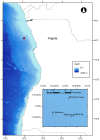Fish food in the deep sea: revisiting the role of large food-falls
- PMID: 24804731
- PMCID: PMC4013046
- DOI: 10.1371/journal.pone.0096016
Fish food in the deep sea: revisiting the role of large food-falls
Abstract
The carcasses of large pelagic vertebrates that sink to the seafloor represent a bounty of food to the deep-sea benthos, but natural food-falls have been rarely observed. Here were report on the first observations of three large 'fish-falls' on the deep-sea floor: a whale shark (Rhincodon typus) and three mobulid rays (genus Mobula). These observations come from industrial remotely operated vehicle video surveys of the seafloor on the Angola continental margin. The carcasses supported moderate communities of scavenging fish (up to 50 individuals per carcass), mostly from the family Zoarcidae, which appeared to be resident on or around the remains. Based on a global dataset of scavenging rates, we estimate that the elasmobranch carcasses provided food for mobile scavengers over extended time periods from weeks to months. No evidence of whale-fall type communities was observed on or around the carcasses, with the exception of putative sulphide-oxidising bacterial mats that outlined one of the mobulid carcasses. Using best estimates of carcass mass, we calculate that the carcasses reported here represent an average supply of carbon to the local seafloor of 0.4 mg m(-2)d(-1), equivalent to ∼ 4% of the normal particulate organic carbon flux. Rapid flux of high-quality labile organic carbon in fish carcasses increases the transfer efficiency of the biological pump of carbon from the surface oceans to the deep sea. We postulate that these food-falls are the result of a local concentration of large marine vertebrates, linked to the high surface primary productivity in the study area.
Conflict of interest statement
Figures



References
-
- Lutz MJ, Caldeira K, Dunbar RB, Behrenfeld MJ (2007) Seasonal rhythms of net primary production and particulate organic carbon flux to depth describe the efficiency of biological pump in the global ocean. Journal of Geophysical Research-Oceans 112. doi:10.1029/2006JC003706 - DOI
-
- Billett DSM, Bett BJ, Reid WDK, Boorman B, Priede IG (2010) Long-term change in the abyssal NE Atlantic The ‘Amperima Event revisited. Deep-Sea Research Part II 57: 1406–1417 10.1016/j.dsr2.2009.02.001 - DOI
-
- Turner R (1973) Wood-Boring Bivalves, Opportunistic Species In The Deep-Sea. Science 180: 1377–1379. - PubMed
Publication types
MeSH terms
LinkOut - more resources
Full Text Sources
Other Literature Sources

